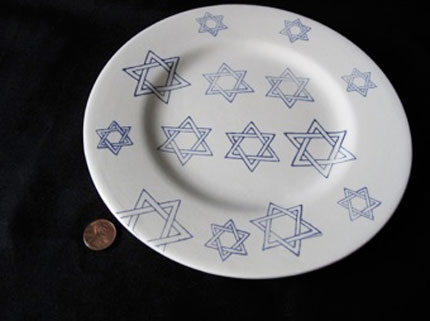
Significant Objects is a much-discussed experiment conducted by Joshua Glenn and Rob Walker. Their hypothesis: if a talented writer invents a story about a thrift-store object, that object will acquire not merely subjective but objective value — on eBay. How better to test this hypothesis than via a week-long collaboration with Design Observer? The first of five stories is by Adam Harrison Levy; it has also been posted to Significant Objects, and the object itself is for sale here on eBay.
Star of David Plate
In my capacity working on documentary films, I’ve met a lot of famous people and stolen great stuff from them — Harry Belafonte's precise V5 roller ball pen, Liza Minnelli's ashtray, and a used Kleenex from Debbie Harry's red leather handbag. Some people collect autographs from famous people. I collect things.
These things represent the defining moments of my life. By stealing objects from people whose lives have been important, I celebrate my encounter with them (at least that is what I tell myself in order to explain what otherwise might be termed theft). A Kleenex is a Kleenex (even when smeared with lipstick) but when its Debbie Harry's Kleenex, it becomes truly important, and it gains even more importance when it joins Belafonte's pen and Minnelli's ashtray in my collection. Right?
So it was a crisp fall afternoon and I had taken the Hamptons Jitney out to see Schulberg, who lives near the ocean. He picked me up in his car. He was ninety-two at the time, and his head just about cleared the dashboard. We made it back to his house more or less in one piece.
We sat down in his living room, which was a jumble of really great stuff. On the mantelpiece was his Oscar for On The Waterfront (patina chipped and damaged and way too obvious to steal), a signed photograph of F. Scott Fitzgerald (framed and therefore too clunky), and a number of sea shells (too cute).
I asked Schulberg questions about his life. During World War Two, he had been a member of John Ford's film unit. His mission was to find and edit Nazi film footage to be used during the Nuremberg Trials. It was the first time that film was used as evidence in an International Court of Law. I was impressed. My own work demands that I view video clips on YouTube.
While he was talking, I spied the plate — which contained some loose change and three paperclips — on the credenza. Something about the simplicity and modernity of its shape reminded me of an Eero Saarinen Tulip Table. The artfully incoherent placement of the stars was like a Dada backdrop. The plate was clearly mass produced. It called out to me. When Schulberg doddered off to take a leak, I slipped the plate — change, paperclips, and all — into my bag.
